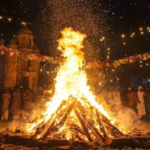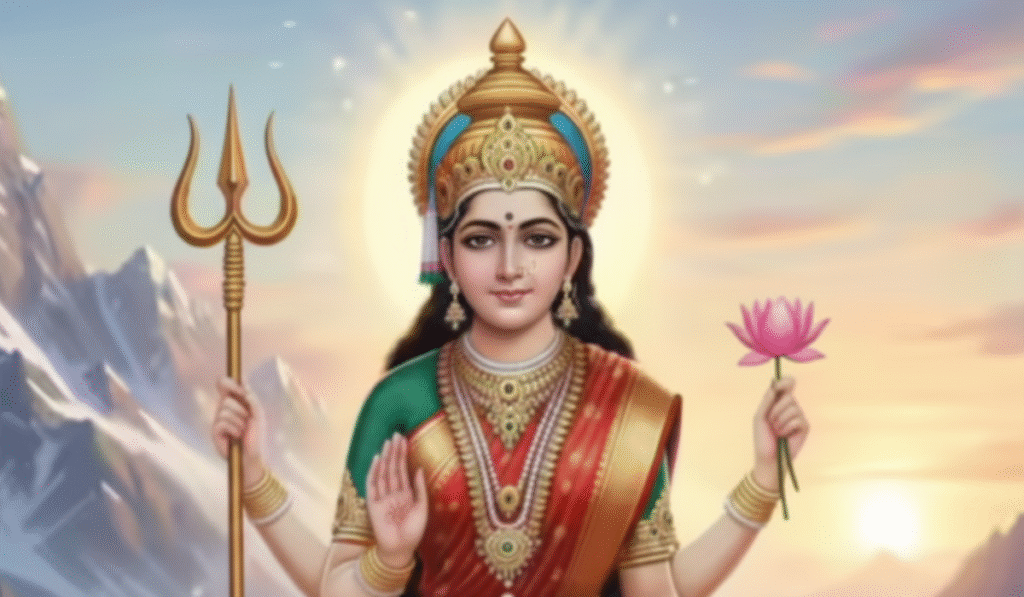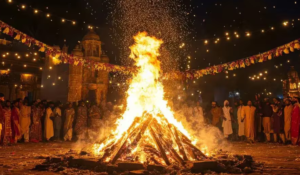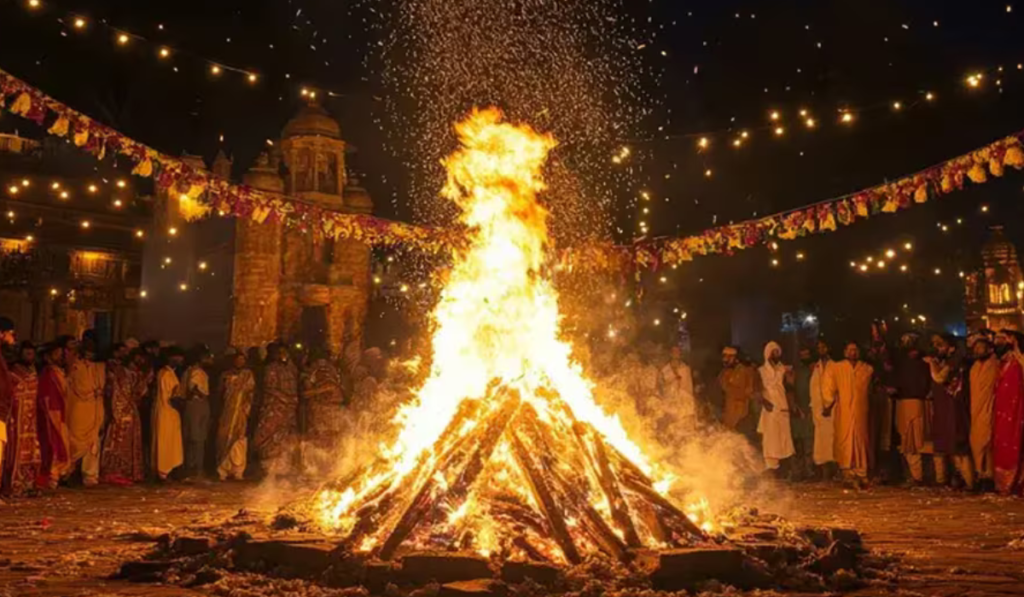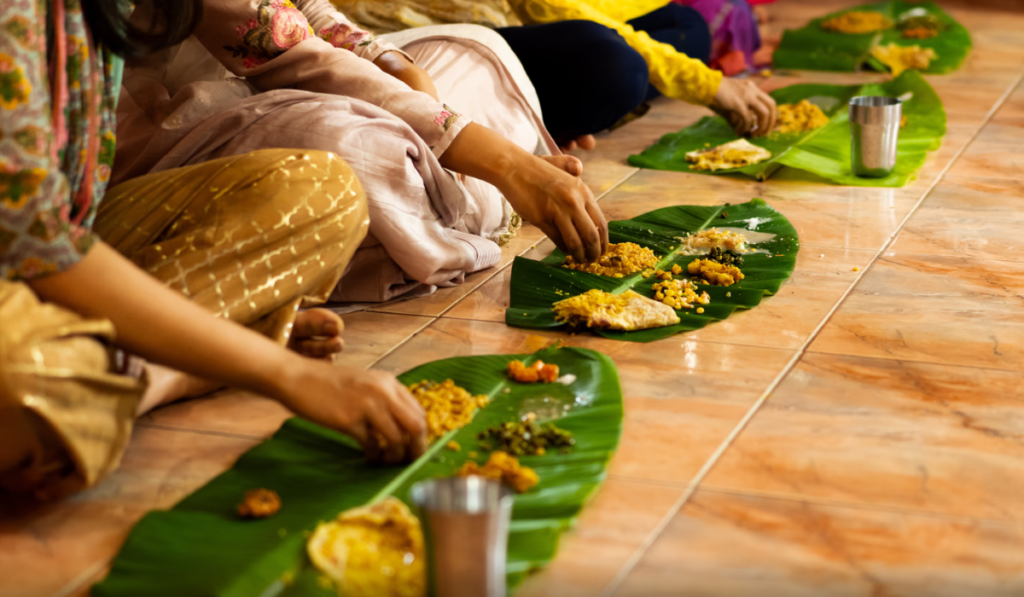The first day of Navratri always feels like the opening of a grand spiritual journey. The day begins with so much positivity and radiance. There is something uncommonly peaceful that seeps into our home. The diya is lit, the kalash is placed, and families bow their heads before the idol of Maa Durga in her very first roop, Maa Shailputri. She is the foundation of Navratri, the beginning of nine nights of devotion.
In Navratri 2025, Day 1 falls on September 22, and devotees all over India will start their prayers with Maa Shailputri, dressed in orange, the color of new energy and spiritual courage. But who is Maa Shailputri? Why is orange chosen for this day? And how should we worship her?
Key Insights
- Day 1 begins with Maa Shailputri, the gentle daughter of the mountains, reminding us that every journey starts with strong roots.
- She is Maa Sati reborn, carrying forward her love and devotion, a true symbol of new beginnings.
- Her form is simple yet powerful: riding on Nandi, holding a trishul for strength and a lotus for purity.
- The color of the day is orange, filling our hearts with warmth, courage, and fresh energy.
- Maa Shailputri blesses us with stability, patience, and balance, grounding us before we take the next step in our Navratri journey.
Who is Maa Shailputri?
Maa Shailputri is none other than our gentle and nurturing Maa Parvati, the better half of Bhagwaan Shiv. But how? The divine name Shailputri is the answer. Shail stands for mountain, and Putri stands for daughter. Maa Shailputri is the daughter of the king of the mountains, King Himavan, also remembered as kind Himavat.
When Maa Sati, the previous birth of Maa Parvati, performed deh tyag in the assembly of Dakshya’s Hawan, she reincarnated as Maa Shailputri, as a daughter of Himavan. But after being married to Bholenath, she was more widely known as Maa Parvati.
So, different names, different forms, but always a kind and motherly embodiment of Adi Shakti.
How is Maa Shailputri Depicted?
How did Maa Shailputri used to look? In our ancient scriptures, such as Markandeya Puran, Durga Saptshloki, and Shilpa Shastra, it is written how Maa Shailputri used to look. In this form, she rides on a Nandi, symbolizing strength and patience. It also signifies the divine ties between Shiv and Shakti, intertwined as one.
In her right hand, she carries a trishul, a reminder of divine power and protection. In her left hand, she holds a lotus, representing purity and spiritual awakening.
With a crescent moon adorning her forehead, Maa Shailputri radiates serenity, grace, and motherly care. She teaches us that every great journey begins with steady faith, humility, and devotion. Her form is simple yet powerful, a blend of calm strength and nurturing energy, making her the perfect goddess to invoke on the first day of Navratri. But why do we worship Maa Shailputri on the very first day of Navratri?
Why Do We Worship Maa Sailputri On the First Day of Navratri?
Day 1 is the new beginning. New journey. And Maa Shailputri is the ultimate example of purity, kindness, and a new chapter. But a new beginning, how? When Maa Sati gave up her soul, it was the end. The end of an era, and nearly the end of the very world we know and live in. To understand this, we must go back to her previous life.
The pain of losing Maa Sati for Bhagwaan Shiv was immense. The rage was uncontrollable. The world was on the brink of annihilation because of Bhagwaan Shiv’s Raudra roop. Not just that, when Shiv lost his calm and serenity, the world lost its balance, from a mere earth to cosmic oceans were about to be destroyed.
The world was being turned into nothingness, Bhagwaan Shiv crying, holding her burnt body in his hands. For him, after losing Sati, the world deserved not salvation, but destruction. But Bhagawan Vishnu intervened and saved the world from the wrath of Bholenath.
So, when Maa Adi Shakti reincarnated as Maa Parvati after Sati, it was a new beginning for not just Bhagwaan Shiva, but for the whole cosmic universe. All gods and demons gathered together on that day when Maa Shailputri was born. Although it was a beginning, the journey from Shailputri to Parvati was intense and a testament to patience. Thus, the true essence of Navratri.
This is why we worship Maa Shailputri on the first day of Navratri.
The Symbolism of Maa Shailputri
Maa Shailputri significance and every detail of Maa Shailputri’s iconography hold deep meaning:
- Nandi: Symbol of strength, patience, and determination.
- Trishul: Victory over evil and inner discipline.
- Lotus: Purity of mind and heart, even in life’s struggles.
- Crescent Moon: Peace, calmness, and control over emotions.
This is why Maa Shailputri is called the foundation of Navratri. Just like a building needs a strong base, our spiritual journey begins with her blessings.
Why Do We Wear Orange on Day 1 of Navratri?
On Day 1, devotees wear orange clothes while worshipping Maa Shailputri because the color represents enthusiasm, warmth, and spiritual awakening. It is believed that by embracing this color, devotees attract Maa’s ashirwad of courage and optimism.
Spiritual and Astrological Significance of Maa ShailPutri
According to the context of Astrology, Maa Shailputri has a major influence on stars. She governs the Chandra, which directly influences our emotions and mind. Worshipping her is believed to calm mental unrest, bring balance, and strengthen one’s inner stability.
She is also connected with the Muladhara Chakra, which we also call the root chakra. By meditating on her, devotees ground themselves, building a strong base for spiritual progress across the nine days of Navratri.
Ritual and Mantras to Worship Maa Shailputri
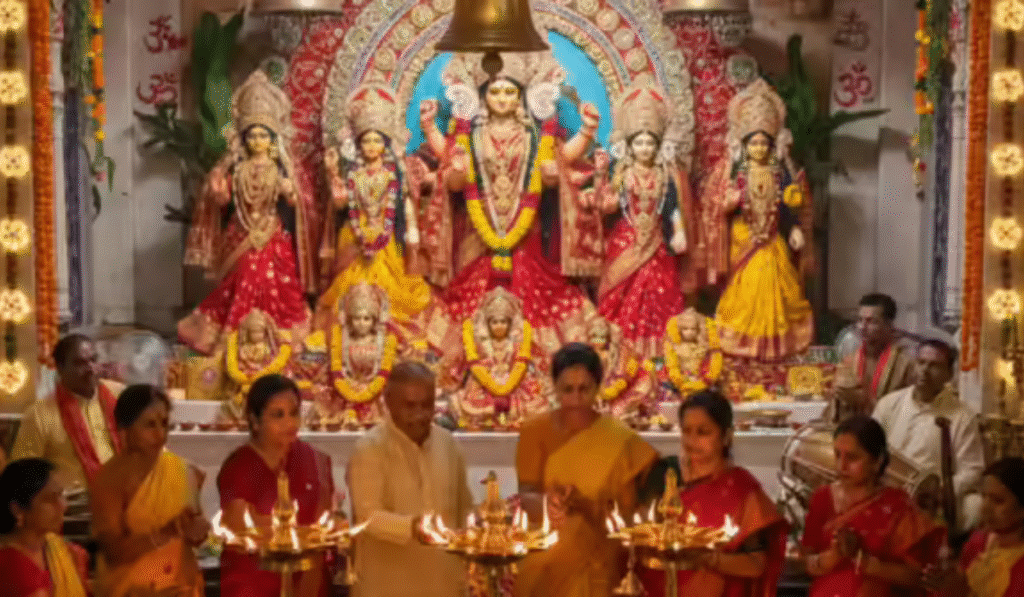
The rituals in Navratra 2025 are the same on all 9 days. However, mantras of each deity are different but very simple.
Rituals
Bhakti and devotion have no wrong ways. Intention is what Maa Durga cares about. However, below are 2 parts of the ritual that are mostly followed around northern India.
- Kalash Sthapna: A thick layer of soil is poured into a flat utensil. A few seeds of rice paddy are sown. Then, Kalash with water or rice is placed with a coconut padded with mango leaves.
- Akhand Jot: On the very first arti poojan of the first day, akhand jot is lighted, which must be burnt throughout the day and night.
Mantras
Below are the two mantras chanted by the devotees to invoke the ashirvad of Maa Shailputri. If you think that the below Mantra is difficult to chant, then just chant a simple Mantra such as the Gayatri Mantra.
Beej Mantra
“ॐ ऐं ह्रीं क्लीं चामुण्डायै विच्चे ॐ शैलपुत्र्यै नमः॥”
Om Aim Hreem Kleem Chamundayai Vichche Om Shailaputryai Namah॥
Prayer
“वन्दे वाञ्छितलाभाय चन्द्रार्धकृतशेखराम्।
वृषारूढां शूलधरां शैलपुत्रीं यशस्विनीम्॥”
Vande Vaanchhita Laabhaya Chandraradha Krita Shekharam।
Vrisharoodhaam Shooldharaam Shailaputrim Yashasvinim॥
Conclusion
Day 1 of Navratri with Maa Shailputri reminds us that every journey begins with grounding, patience, and the blessings of Adi Shakti. But Navratri is a path of progression, each day taking us deeper into Maa’s different roop.
On Day 2, we’ll learn more about Maa Brahmacharini, the goddess of unmatched tapasya and devotion. But why does she choose to walk barefoot, carrying only a japmala and kamandal? What hidden meaning lies in her simple appearance? How did her tapasya shake even Lord Shiva himself? And most importantly, what can her story teach us about handling struggles in our own lives with grace and determination?
Stay with us as we uncover the mysteries of Maa Brahmacharini tomorrow on MyFavoriteCorner.
Let’s stay connected! Come say hi on Instagram or follow us on Facebook for daily inspo.





